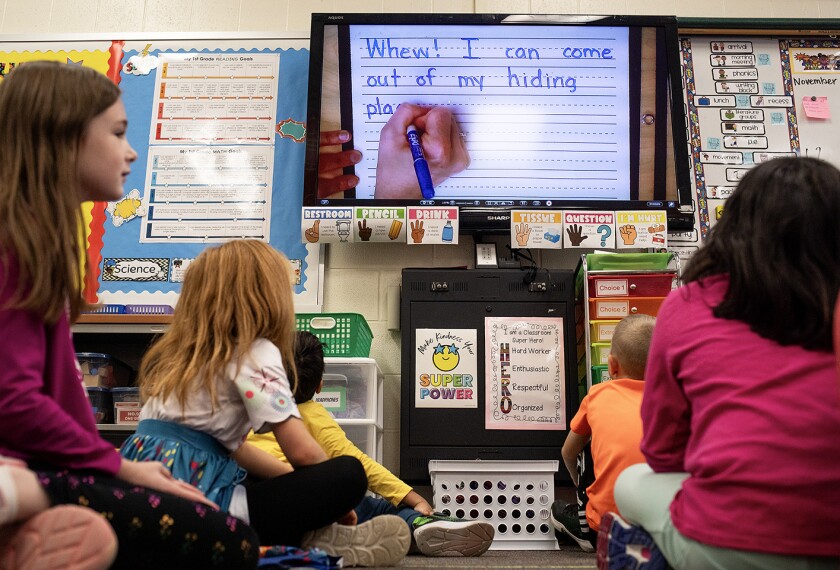Corrected: This article originally included an incorrect location for Saxon Publishers Inc. The company is based in Norman, Okla.

Thanks to the Third International Mathematics and Science Study, one of Singapore’s most talked-about exports these days is neither the computer equipment from its factories nor the rubber from its plantations.
It’s mathematics textbooks.
Elementary and middle school students in the 247- square-mile Southeast Asian nation ranked first in the world on the math portions of the TIMSS assessments, which were given in 1994 and 1995. To earn that title, Singaporeans outpaced their counterparts in 39 other countries, including such educational powerhouses as Japan and Taiwan. They also outscored students in Belgium, Canada, France, Hong Kong, and Switzerland. And they beat the United States.
Now, scattered groups of educators in this country are hoping the textbooks from that island nation hold the secret to Singaporean students’ notable success.
Sales of the books, which are published in English, have multiplied since 1998, according to their sole U.S. distributor, a West Linn, Ore., firm named Family Things. The mom-and-pop company says it has filled orders for “several thousand” of the paperbacks so far this school year. And the volumes are going to a wide range of educators, including home schoolers, private school operators, and public schools from Colorado to Maryland.
Early Algebra
Primarily black and white, the books contain none of the colorful, eye-popping graphics that publishers incorporate into many American textbooks to grab students’ attention.
But admirers of the math books praise them for their clear, simple text, their novel problem- solving approaches, and the complex, multistep problems they give students, beginning in 1st grade.
“I think these books really empower students as problem-solvers,” said Felicity Messner Ross, a math teacher at Robert Poole Middle School in Baltimore. “So, if they see a problem they’ve never seen before, they’ll think they have the tools to solve it.”
Students are introduced to algebra concepts early, for example, through word problems that seem more at home in high school texts. But, rather than use algebraic equations to solve the problems, the books present pictorial strategies that are easily grasped by elementary-level pupils.
“There is a great insistence on full understanding, and an avoidance of mindless rituals that lead to a solution,” said Yoram Sagher, a mathematics professor at the University of Illinois at Chicago. Between his university math education duties, Mr. Sagher crisscrosses the country teaching practicing teachers, such as Ms. Ross, how to put the texts from Singapore to good use. Many of those sessions are financed by the Gabriella and Paul Rosenbaum Foundation, a Chicago-based family philanthropy that promotes math achievement.
Ms. Ross’ 6th and 7th graders are taking part in a privately subsidized, citywide program aimed at grooming mathematically talented students. And those bright-eyed and able students clearly relish the challenge the books provide.
“They’re a lot more challenging than our other books,” said 7th grader Renae Mitchell, “but that’s, like, a good thing.”
Whether due to the textbooks or not, students in the program, known as the Ingenuity Project, have gone on to receive honors in local and national mathematics competitions. Two 9th graders, in fact, scored in the top 1 percent on a national mathematics competition last February.
Schools in Chicago, Montgomery County, Md., and Paterson, N.J., are also piloting the books for more heterogeneous student populations, including some children who find school a struggle.
One bonus for students using the books is that they are thinner and lighter than most American-made math texts. A drawback is that the books are riddled with unfamiliar names, British-flavored spellings and terms, and metric measurements.
“Mr Chen has to drive to Malacca which is 240 km from Singapore,” begins one such problem in a 5th grade text. “If his car can travel 15 km on 1 litre of petrol, how many litres of petrol does he need for the trip?”
“Every once in a while, there’ll be some words we don’t understand, but Ms. Ross explains them to us, so it’s no big deal,” 7th grader Kyle Halle-Erby said.
‘A Different Culture’
Like the math texts published by Saxon Publishers, a small, Norman, Okla., firm, the Singapore text may buck current American trends in mathematic education, and local or national standards for teaching the subject.
“My sense is that some of the ideas about what’s important in algebra are probably missing,” said Gail Burrill, a past president of the National Council of Teachers of Mathematics, which created a set of widely adopted math standards in the early 1990s. “The emphasis in NCTM is on children making sense of things, exploring and investigating patterns, and building skills and conceptual understanding. A lot of the conceptual understanding that we would think is important is not evident from looking at this material.”
But Ms. Burrill, who is the director of the National Research Council’s Mathematical Sciences Education Board in Washington, acknowledges that her review of the books was cursory. In their favor, she added, the Singaporean texts lay out a coherent curriculum and avoid needless repetition.
“I would hope that districts are paying attention to what’s in the books, but I also hope they would understand these are books used by a different culture, a culture that is more homogeneous, and a culture that has a consistent way of thinking about mathematics,” she added.
Though Singaporeans speak a mix of languages, more than 90 percent of the 4.2 million residents of the former British colony are literate.The central Ministry of Education develops textbooks in every subject, and students pay a fee to use them.
Singaporean parents, like parents in other Southeast Asian countries, also typically supplement their children’s learning with after-school tutoring sessions.
Even proponents of the math textbooks say American teachers need tutoring themselves to use the books well.
“These books are not what the current generation of teachers knows how to deal with,” said Madge Goldman, the president of the Rosenbaum Foundation. “The material is only part of the story.”





